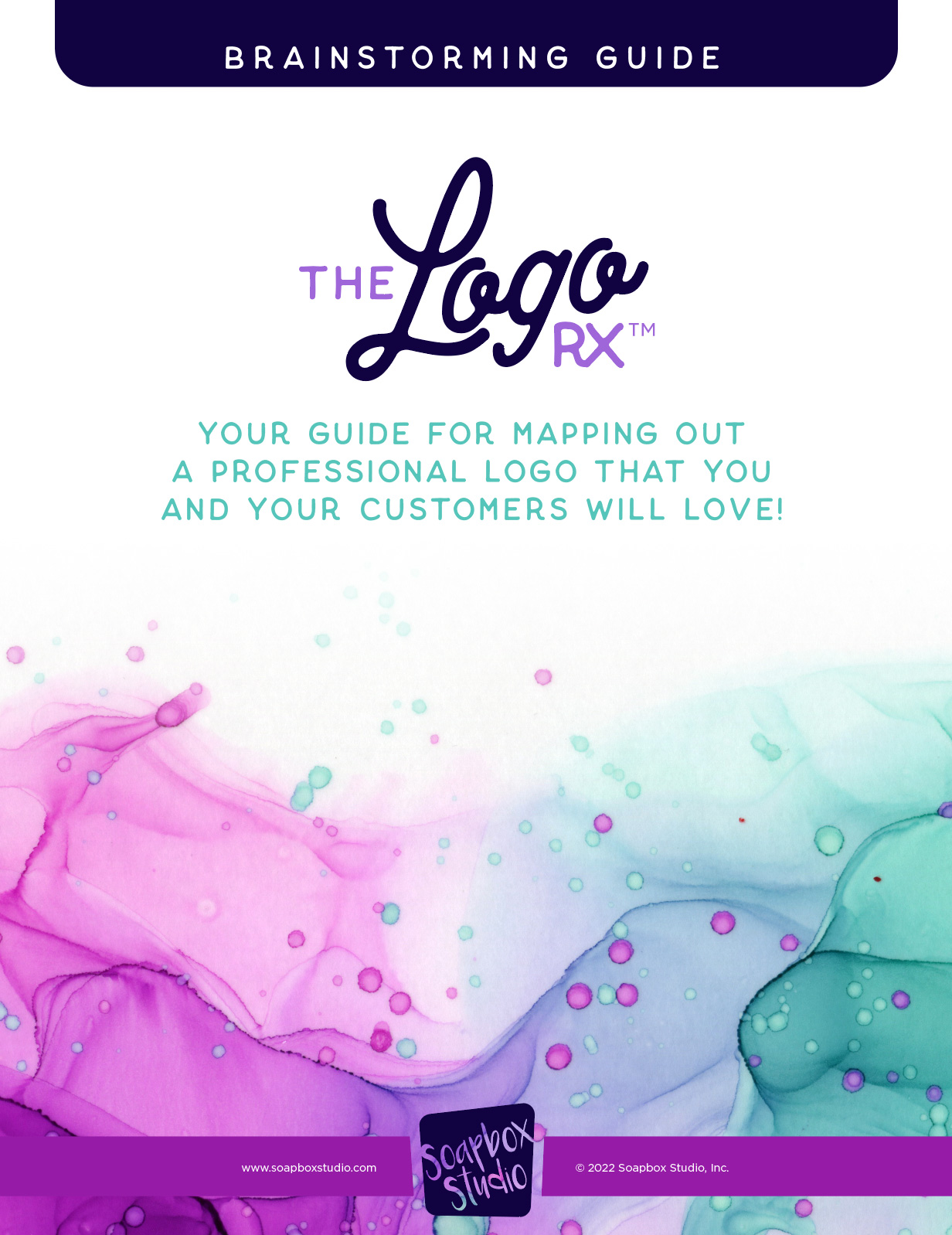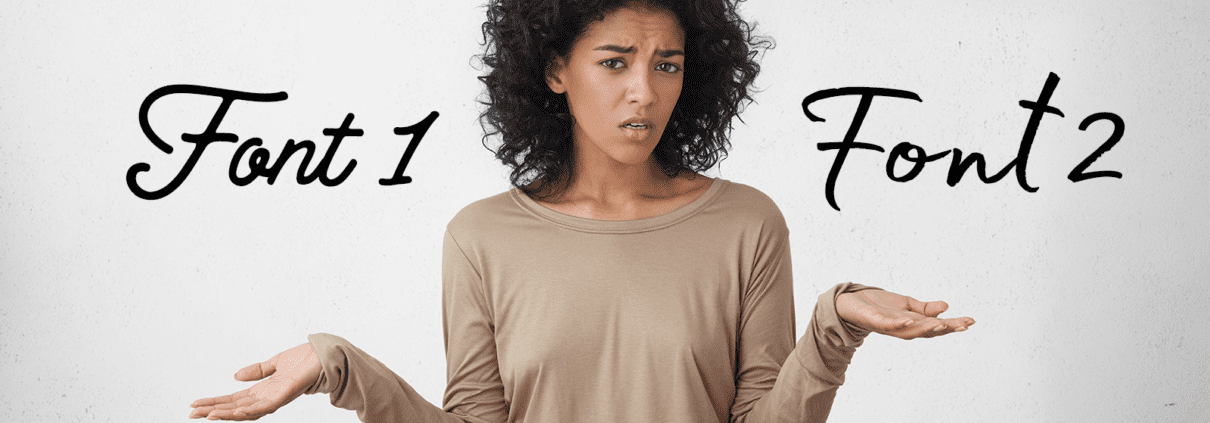How to Choose the Right Font for Your Brand
Branding requires consistency. When you have a defined identity, communicating that identity clearly every time, is what makes branding important. As fun as it might be to change up your look, it can confuse your customers and make them wonder if they came to the right place. As you’re establishing your brand colors and designs, it’s crucial not to forget the significance of fonts in establishing the tone of your company. If this seems complicated, we’ve compiled all the information you need to know on how to choose the right font for your brand.
If you’re just at the beginning of establishing your brand identity, you’ll need to decide a few things before you find fonts:
Brainstorm Your Logo Creation Today!

This guide will walk you through the steps I use as a professional designer, to create beautiful logos for all my clients. I am sharing my steps for FREE, so you can use this secret sauce on your own logos.
- The name of your brand or company
- Who your target audience is
- What you do
- What sets you apart
- The tone of your brand
- Colors that represent what you stand for
- A logo design that encapsulates this identity
To help you think through these elements, we’ve created a downloadable pdf called Logo RX. This guide will walk you through every question you need to be asking yourself so you don’t miss any crucial details while you establish your company’s brand identity.
Fonts as identity
The last two items on the list are not necessarily prerequisites to find the right font, but they help you choose elements representing your brand identity. As you establish the tone of your brand, it’s important not to pick the colors and fonts that you personally prefer. Just because you like the look of a font doesn’t mean it communicates your brand identity well. Of course, your preferences can be a part of your design, as long as they align well with the company’s core values. Combined with a solid logo and website design, the tone of your font can make your branding feel more consistent, streamlined, and clear.
So, do you know what tone communicates your brand identity best?
Some words to choose from might be:
- Accessible
- Ambitious
- Approachable
- Beauty-centric
- Bold
- Bright
- Calm
- Casual
- Cheerful
- Classic
- Conservative
- Contemporary
- Convenient
- Cool
- Creative
- Cultured
- Custom
- Cutting-edge
- Delicate
- Delightful
- Dynamic
- Easy
- Efficient
- Elegant
- Enduring
- Energetic
- Exclusive
- Familiar
- Fashion-forward
- Fearless
- Flexible
- Formal
- Fresh
- Friendly
- Fun
- Functional
- Generous
- Gentle
- Harmonious
- Helpful
- Honorable
- Human
- Industrious
- Informal
- Instinctive
- Innovative
- Inviting
- Knowledgable
- Lovely
- Mature
- Modern
- Natural
- Noble
- No-nonsense
- Original
- Peaceful
- Personable
- Plain
- Playful
- Polished
- Professional
- Quirky
- Reflective
- Reliable
- Romantic
- Rustic
- Secure
- Serious
- Sincere
- Sleek
- Sophisticated
- Spiritual
- Thoughtful
- Thrifty
- Timeless
- Trendy
- Trustworthy
- Unique
- Unconventional
- Vivacious
- Versatile
- Warm
- Wise
- Witty
- Zany
Once you’ve identified a few of these words to describe your brand’s identity, you will want to browse through different fonts to find a type format that communicates this tone. Every brand needs the fonts they choose to be easy-to-read, not too familiar, and operational in all colors.
Easy-to-Read
If you choose a font that is too thin, too thick, too spread apart, too italicized, too swirly, or too artistic, it may not be the right font for your brand. If a font is too hard to read, you will not clearly communicate your identity. You want someone to tell exactly what your wording says, whether it’s plastered on a billboard or written in 10—point font on a business card. To check if a font is easy to read, you can significantly increase and decrease the font size. You may have a different font for headlines or titles than you have for subtitles or slogans. In fact, many brands do. But in either case, you need to choose a font that is easy to read.
Not Too Common
Obviously, you don’t need to select a crazy font with a strange look to stand out, but if it’s too common, it might look like a third-grader chose it. Think of the most common fonts like Arial, Calibri, New Times Roman, Georgia, Cambria, Impact, and Comic Sans. These are fonts easily accessible in Word processors and frequently used for education, writing, and everyday purposes. If you select one of these fonts for your brand, you will be perceived as ordinary and uncreative. It may also make people think you are less credible because you used the first font on the list.
Works in All Colors
Some fonts have cutouts or utilize negative space as part of the design. These fonts can look cool but are often designed to be black with a white background. If you change the background color or the font color, are the words still legible? Does the design still look cool? Or is it evident that the font was not created with this purpose in mind? Little details like this can make a difference for your audience. If you make a glaring mistake like this, they may not think you care about the details or can provide a professional-quality product or result.
Why Does Font Impact Credibility?
Your credibility as a company is one of your most valuable assets. There will always be external influences that impact how people view you. These might be out of your control. However, you want to be certain every choice you make improves your credibility. Choosing the right font has the power to do this.
If your company gives people legal advice or helps them produce contracts to minimize liabilities, using comic sans as a font could destroy your credibility. People will think of your company as childish, unprofessional, immature, and unpolished. These words confuse your audience and oppose your company’s core values.
If you own a fashion company that is simple, feminine, modern, and dainty, you should not use a thick or rustic font. Using Impact or Roboto Mono will create the wrong impression. People will take one look at your text and make decisions about whether they like your brand based on text that is giving off the wrong connotations. Similarly, if you are a masculine and rigged brand, using a cursive and curly font will communicate the opposite message.
While these are extreme examples, they do extend to more subtle fonts. In addition, there are different font categories that you can choose from, and each carries connotations that can help or hurt your brand, it all comes down to whether or not it’s right for your brand.
Serif and Sans Serif Fonts
Serif is a title that refers to the tiny “feet” at the ends of letters. Sans Serif is “without feet” and is the category of fonts we use on this site. A typewriter font is a serif font because it includes these extra strokes. Many Serif fonts are perceived as more formal, classic, and official. Without the extra strokes, Sans serif fonts are viewed as more simple, modern, informal, and elegant. We typically try and stay away from using serif fonts as all caps in headlines because it makes the copy harder to read. If you want to use all caps to capture attention in that way stick with a sans serif font.
Bold or Italicized
While many basic fonts have bold or italicized options, some fonts were created with these features in mind. A bold font gives a strong impression that is perceived as unyielding and confident. On the other hand, an italicized font can be perceived as more fancy, suggestive, quoted copy and elegant. Write out your title or slogan and see how it looks with these different features applied.
Script or Handwritten Fonts
Fonts that were designed to look like handwriting can be a fun addition, but should be used sparingly. These fonts are better to use as accent than a main staple. They are good for logos but not for large amounts of copy. By using a handwriting accent, your brand can be perceived as more creative or eye catching. However, with these kinds of fonts less it more. Never use one with all caps or letter spacing because it makes you look unprofessional.
Boxy or Curvy
For some of the more subtle fonts, you’ll want to pay attention to the lines. Are they straight and boxy, or curved and rounded? Each type of line communicates differently about your brand. Straight lines are more modern and straightforward. Curved fonts are more unique and creative. The boxiest fonts look technical and robotic, while the most rounded fonts mimic handwriting and feel more casual. Try some fonts out and see how your brand title looks in different font styles.
All Caps, Lowercase, Sentence Case, and Title Case
This might not even be something you’ve thought about, but different brands utilize this element to communicate their brand identity all the time. Using all caps is bold, unapologetic, and easy to read. Using all lowercase is a bit unconventional, informal, and casual. It would be best to avoid all lowercase with an older audience. Sentence case, with the first letter capitalized and everything else lowercase, is very standard and classic and commonly used in body copy. Title case is when all words except for articles, conjunctions, and short prepositions are capitalized and most commonly used in longer headlines or sometimes bullet points. In this paragraph, the title “All Caps, Lowercase, Sentence Case, and Title Case” is Title Case and the rest of the paragraph is Sentence Case.
Font Combinations
Most brands utilize more than one font in their brand guidelines. For example, they might use one or two fonts in their logo, and another one or two for their standard font on the website or print materials. You don’t necessarily have to use your logo font on your print material. In fact, many companies do not since their logo is very specialized or sometimes custom created. So the logo font is kept special for the logo. You can work with a graphic designer or brand specialist to help identify what fonts are appropriate for your communications. If you’re curious, try a few different font combinations out and see how they look together. A good rule of thumb is not to use more than two fonts in a logo. If you have one really unique font, you’ll want the others to be simple so that people don’t feel visually overwhelmed.
Fonts can be powerful
Your font can be a powerful communicator of your brand identity in combination with your logo design, brand colors, and website design. With the right font choice, you can communicate your company’s tone and establish credibility with your target audience. With one glance, your customers or clients will understand who you are, what you do, and how you can help them. Instead of using fonts and colors that work against you, the right choices will build trust and set you apart from the competition.
If you are still stuck on how to choose the right font, talk with a designer to identify how to tie those fonts in with the colors and designs that your brand is already using. Ultimately, communication is in so much more than the words you use, and a font will build credibility for your brand in more ways than one! For targeted help choosing the elements that will work best for your brand, check out our Logo RX brainstorming guide. This free downloadable guide will help you think through all elements of your logo and brand identity from the colors to the design to the fonts. For more specialized help, check out our Logo Rx program to develop a professional logo and brand design with the help of a professional so you don’t get lost in the details.





